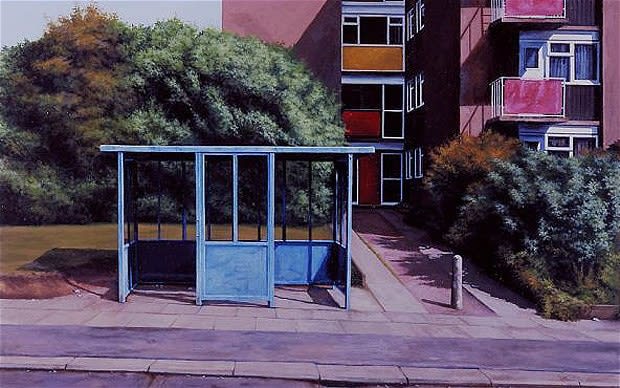By Bernadetta McNulty for The Telegraph, 2 December 2011
'I just want to shake your hand.” Trying to talk to George Shaw on the opening day of his exhibition at Coventry’s Herbert Gallery is proving to be a difficult task. As soon as someone recognises him, they want to come up and tell him they went to school with him or how they still live on the Tile Hill estate that has been the subject of his paintings for the past 15 years. All of them want to shake his hand, to tell him how wonderful they think his paintings are. Even the local paper has gone to town, declaring on the front page, “King George returns.”
The artist, mildly hung over from the 3am finish of the gallery party the night before, treats each approach the same way: happy to chat, he is gracious, funny, warm, at ease. There are no barriers – or if there are he doesn’t betray them. With his Coventry accent intact, he still seems very much “one of them”. “I had an interviewer from a local radio say to me that I didn’t look like an artist. He was expecting someone in a tweed jacket with a beard.”
You can understand the locals’ delight. The 45 year-old, the favourite to take the Turner prize next week, is the biggest star to come from Coventry since his beloved band the Specials, or before that, the poet Philip Larkin. Visitors to the exhibition, sweetly titled I Woz Ere, are greeted by a quotation from a Larkin poem that seems to sum up Shaw’s elevation of an unloved and unpainted corner of Britain, with the lines, “Here leaves unnoticed thicken/Hidden weeds flower, neglected waters quicken.” But, next to it is a statement from Shaw that cautions those in search of simple snapshots of where they live: “My work is not historical or social documentation. It grows out of my imagination, my own heart and my own anxieties.”
Shaw perhaps more than any other recent artist has become a lightning conductor for a debate about what art should look like. When I saw his Turner-nominated exhibition The Sly and Unseen Day at the Baltic gallery in Gateshead earlier this year, like many people I was utterly transported by the portrayal of the Midlands world that was my formative world too: bus stops, underpasses and garages, circled by the watery skies and shadowy trees that Shaw renders almost perfectly in the glassy textures of the same Humbrol enamel paints that he used to decorate Airfix models with as a boy.
Yet, in works devoid of human life, with elliptical, seemingly religious titles such as The Assumption or Scenes from the Passion, people from outside Tile Hill perceive the vistas of their own childhoods; or in the decaying landscapes they see broken Britain, where the dream of post-war utopian living has ended in sink estates and ugly urban sprawl. Many critics detect a sinister air in the work. Others rejoice at a return to the medium of painting: detractors sniff at what they see as Shaw’s banal conservatism. Everybody seems to see their memories, their prejudices, their hopes or fears reflected back in those impenetrable surfaces.
